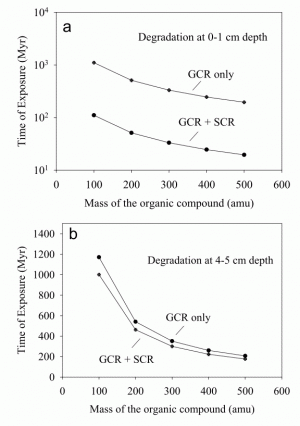Everyone knows Mars has a terrible environment: temperatures are bitter cold most of the time, there’s almost no air pressure, and solar ultraviolet light scours the surface unhindered.

COVER UP TO SURVIVE. Cosmic rays from space rapidly destroy organic materials that lie near the Martian surface. The exposure times (left side) indicate how long it takes cosmic rays to decrease the materials by a thousand-fold (SCR = solar cosmic rays, GCR = galactic cosmic rays). Image taken from Figure 3 in the paper.
Actually, it’s even worse. Alexander Pavlov (NASA Goddard Space Flight Center) and colleagues ran computer experiments in which they subjected organic compounds to the cumulated effects of cosmic rays from solar and galactic sources. Their report appears in Geophysical Research Letters.
The news, as the saying goes, is both good and bad. First, the bad: any organic compound lying close to the surface will be destroyed within a few hundred million years. This timescale, while long in human terms, counts as but a fraction of Mars’ 4.5 billion year history.
Galactic cosmic rays do the worst, they found, but both sources produce enough ionizing radiation to severely damage organic materials.
The good news is the flip side. Which is that any material buried more than 4 or 5 inches below the surface has a good chance of surviving mostly intact over geologic timescales.
“The preservation of ancient complex organic molecules in the shallow (~10 cm [4 inches] depth) subsurface of rocks could be highly problematic if the exposure age of a geologic outcrop would exceed 300 million years,” they team writes.
Looking at the chances of Curiosity, NASA’s Mars Science Laboratory, for finding organics, the researchers see problems looming. “[It] will pose a serious challenge for organic detection by MSL since its primary focus is to look for 3.5 billion-year-old organic biomarkers while only drilling 5 centimeters [2 inches] into the surface rock.”
However, some sampling options are available for the mission’s scientists and engineers. “Several straightforward strategies would still allow the MSL to sample relatively ‘fresh’ ancient rocks, ” they say. One strategy would be to look for recent craters in the 1 to 10 meter [3 to 30 feet] diameter range within Gale.
Another strategy would involve using Curiosity’s wheels to dig into soft sedimentary rock before drilling. Given the size of the rover’s wheels such digging could provide samples from about 20 centimeter [8 inch] depths.
“Although a depth of 20 cm is not enough to avoid degradation by galactic cosmic rays completely,” they note, “it can slow down the rate of organic destruction by about 30% and will eliminate degradation associated with solar cosmic ray irradiation completely.”








